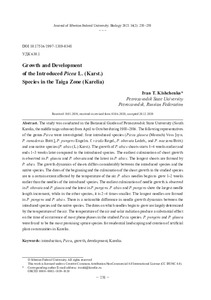Рост и развитие интродуцированных видов Picea L (Karst.) в таежной зоне (Карелия)
Скачать файл:
URI (для ссылок/цитирований):
https://elib.sfu-kras.ru/handle/2311/141377Автор:
Кищенко, И. Т.
Kishchenko, Ivan T.
Дата:
2021-06Журнал:
Журнал Сибирского федерального университета.Биология. Journal of Siberian Federal University.Biology, 2021 14 (2)Аннотация:
Исследования проводили в 1988–2016 гг. с апреля по октябрь в Ботаническом саду
Петрозаводского государственного университета (Южная Карелия, подзона средней тайги).
Объектами исследований служили представители рода Picea: четыре интродуцированных вида
(Picea glauca (Moench) Voss [syn. P. canadensis Britt.], P. pungens Engelm. f. viridis Regel., P. obovata
Ledeb., P. mariana Britt.) и один аборигенный (P. abies (L.) Karst.). Рост побегов у P. abies начинается
на 1–4 недели раньше, а заканчивается на 1–3 недели позже, чем у интродуцентов. Ранее всего
кульминация прироста побегов происходит у P. glauca и P. obovata, а позже всего – у P. abies.
Наиболее длинные побеги формируются у P. abies. Динамика прироста побегов у интродуцентов
значительно отличается от таковой у аборигенного вида. Начало роста побегов и кульминация их
прироста у изучаемых видов в определенной мере зависит от температурного режима воздуха.
Рост хвои у P. abies начинается на 1–2 недели раньше, чем у интродуцированных видов. Ранее
всего кульминация ее прироста происходит у P. obovata и P. glauca, а позже всего – у P. pungens.
Наибольшая величина прироста хвои характерна для P. abies и P. pungens, у других видов она в 2–4
раза меньше. Наиболее длинная хвоя формируется у P. pungens и P. abies. Динамика прироста
хвои у интродуцентов существенно отличается от таковой у аборигенного вида. Начало роста
хвои в значительной степени зависит от температурного режима воздуха. Существенное влияние
на сроки прохождения большинства фенофаз изученных видов рода Picea оказывает температура
воздуха и солнечная радиация. Наиболее перспективными для озеленения населенных пунктов
и создания культурценозов в Карелии оказались P. pungens и P. glauca The study was conducted in the Botanical Garden of Petrozavodsk State University (South Karelia, the middle taiga subzone) from April to October during 1988–2016. The following representatives of the genus Picea were investigated: four introduced species (Picea glauca (Moench) Voss [syn. P. canadensis Britt.], P. pungens Engelm. f. viridis Regel., P. obovata Ledeb., and P. mariana Britt.) and one native species (P. abies (L.) Karst.). The growth of P. abies shoots starts 1–4 weeks earlier and ends 1–3 weeks later compared to the introduced species. The earliest culmination of shoot growth is observed in P. glauca and P. obovata and the latest in P. abies. The longest shoots are formed by P. abies. The growth dynamics of shoots differs considerably between the introduced species and the native species. The dates of the beginning and the culmination of the shoot growth in the studied species are to a certain extent affected by the temperature of the air. P. abies needles begin to grow 1–2 weeks earlier than the needles of the introduced species. The earliest culmination of needle growth is observed in P. obovata and P. glauca and the latest in P. pungens. P. abies and P. pungens show the largest needle length increment, while in the other species, it is 2–4 times smaller. The longest needles are formed in P. pungens and P. abies. There is a noticeable difference in needle growth dynamics between the introduced species and the native species. The dates on which needles begin to grow are largely determined by the temperature of the air. The temperature of the air and solar radiation produce a substantial effect on the time of occurrence of most phenophases in the studied Picea species. P. pungens and P. glauca were found to be the most promising spruce species for residential landscaping and creation of artificial plant communities in Karelia
Коллекции:
Метаданные:
Показать полную информациюСвязанные материалы
Показаны похожие ресурсы по названию, автору или тематике.
-
Распределение морозобойных повреждений в древесине ели сибирской (picea obovata ledeb.) на склонах разной экспозиции в горах Южного Урала
Гурская, М.А.; Gurskaya, Marina A.; Моисеев, П.А.; Moiseev, Pavel A. (Сибирский федеральный университет. Siberian Federal University., 2011-12)На северо-восточном (СВ) и юго-западном (ЮЗ) склонах массива Иремель (Южный Урал, 54 30 -34 с.ш. 58 49 -54 в.д.) в экотоне верхней границы древесной растительности (1255- 1365 м над ур. м.) заложены 34 пробные площади, ... -
Комплексные исследования отклика фотосинтетического аппарата ели сибирской (Picea obovata Ledeb.) на воздействие УФ-В-радиации
Зуев, В.В.; Zuev, Vladimir V.; Зуева, Н.Е.; Zueva, Nina E.; Зотикова, А.П.; Zotikova, Albina P.; Бендер, О.Г.; Bender, Olga G.; Правдин, В.Л.; Pravdin, Vladimir L. (Сибирский федеральный университет. Siberian Federal University., 2010-12)Характер влияния ультрафиолетовой радиации на физиологические процессы растения зависит от длины волны, интенсивности и продолжительности облучения. В статье представлены результаты комплексного исследования влияния ... -
Изучение возможностей использования ели сибирской (Picea obovata Ledeb.) и сосны обыкновенной (Pinus sylvestris L.) в биоиндикации загрязнения воздуха
Ноздрина, Ю. В.; Симонова, Т. А. (Сибирский федеральный университет, 2009-10-25) -
Divergent growth trends and climatic response of Picea obovata along elevational gradient in Western Sayan mountains, Siberia
Ваганов, Евгений Александрович; Babushkina, E; Belokopytova, L; Zhirnova, D.; Barabantsova, A. (2018-11)In mountain ecosystems, plants are sensitive to climate changes, and an entire range of species distribution can be observed in a small area. Therefore, mountains are of great interest for climate–growth relationship ... -
Mating system in a native Norway spruce (Picea abies [L.] KARST.) stand-relatedness and effective pollen population size show an association with the germination percentage of single tree progenies
Care Oliver; Gailing Oliver; Mueller Markus; Krutovsky Konstantin; Leinemann Ludger (2020)Norway spruce differs little in neutral genetic markers among populations and provenances often reported, but in terms of putative adaptive traits and their candidate genes, some clear differences have been observed. This ...

